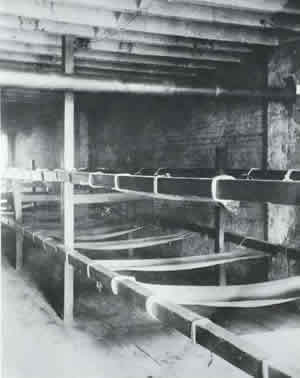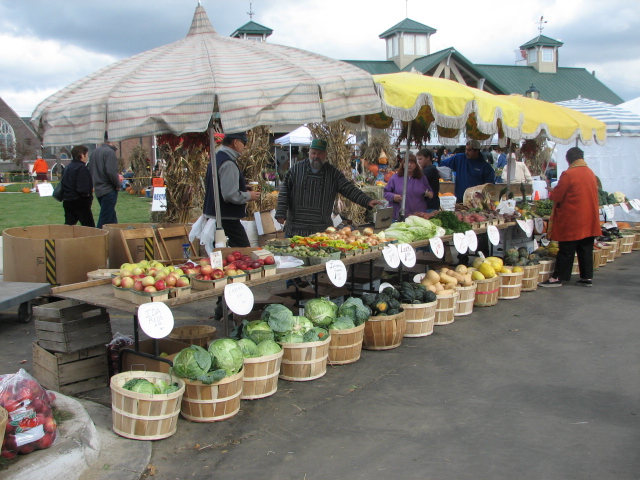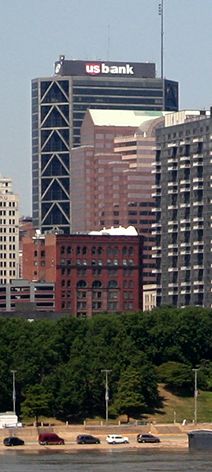|
Nicollet Mall
Nicollet Mall is a twelve-block portion of Nicollet Avenue running through downtown Minneapolis, Minnesota, United States. It is the shopping and dining district of the city, and also a pedestrian mall and transit mall. Along with Hennepin Avenue to the west, Nicollet Mall forms the cultural and commercial center of Minneapolis. Several notable Minneapolis buildings line the Mall, notably the IDS Center, the former Dayton's flagship store, Orchestra Hall (Minneapolis), Orchestra Hall, and the Minneapolis Central Library. Minneapolis CBS Station WCCO-TV broadcasts from studios and offices on the south end of the Mall. Several major companies have their headquarters along the Mall, including Target Corporation and US Bank. On Thursdays during the summer, the Nicollet Mall hosts a farmers' market while in the winter the Holidazzle Parade, now entitled "Holidazzle Village", are hosted in the Mall. History By the beginning of the 20th century, Nicollet Avenue had defined itself as t ... [...More Info...] [...Related Items...] OR: [Wikipedia] [Google] [Baidu] |
Nicollet Avenue
Nicollet Avenue is a major street in Minneapolis, Richfield, Bloomington, and Burnsville in the U.S. state of Minnesota. It passes through a number of locally well-known neighborhoods and districts, notably Eat Street in south Minneapolis and the traffic-restricted Nicollet Mall in downtown Minneapolis. History It began as a military road between St. Anthony Falls and Fort Snelling. Nicollet Avenue was named for early 19th-century French explorer and cartographer Joseph Nicollet, who led three expeditions in what is now Minnesota. Nicollet Mall occupies the oldest section of the avenue. Before the mall was constructed in 1968, Nicollet Avenue stretched from the Mississippi River to the Minnesota River. One block of the street between 29th Street and Lake Street was removed in the 1977 to build a K-Mart store (opened in 1978) which covers two city blocks, detouring southbound traffic to Blaisdell Avenue and northbound traffic to First Avenue South. The city of Minneapolis h ... [...More Info...] [...Related Items...] OR: [Wikipedia] [Google] [Baidu] |
Hennepin Avenue
Hennepin Avenue is a major street in Minneapolis, Minnesota, United States. It runs from Lakewood Cemetery (at West 36th Street), north through the Uptown District of Southwest Minneapolis, through the Virginia Triangle, the former "Bottleneck" area west of Loring Park. It then goes through the North Loop in the city center, to Northeast Minneapolis and the city's eastern boundary, where it becomes Larpenteur Avenue as it enters Lauderdale in Ramsey County at Highway 280. Hennepin Avenue is a Minneapolis city street south/west of Washington Avenue, and is designated as Hennepin County Road 52 from Washington Avenue to the county line. Cultural impact For sections south of the Mississippi River, Hennepin Avenue follows stretches of an old Indian trail from Saint Anthony Falls to Bde Maka Ska. It was named after Father Louis Hennepin, a Roman Catholic priest who explored the interior of North America for France while it was under French control. Hennepin Avenue is one of the old ... [...More Info...] [...Related Items...] OR: [Wikipedia] [Google] [Baidu] |
Flophouse
A flophouse (American English) or dosshouse (British English) is a place that offers very low-cost lodging, providing space to sleep and minimal amenities. Characteristics Historically, flophouses, or British "doss-houses", have been used for overnight lodging by those who needed the lowest cost alternative to staying with others, shelters, or sleeping outside. Generally rooms are small, bathrooms are shared, and bedding is minimal, sometimes with mattresses or mats on the floor, or canvas sheets stretched between two horizontal beams creating a series of hammock-like beds. People who make use of these places have often been called transients and have been between homes. Quarters are typically very small, and may resemble office cubicles more than a regular room in a hotel or apartment building. Some flophouses qualify as boarding houses, but only if they offer meals. American flophouses date at least to the 19th century, but the term ''flophouse'' itself is only attested fr ... [...More Info...] [...Related Items...] OR: [Wikipedia] [Google] [Baidu] |
Gateway District (Minneapolis)
Kasota building in 1927 Gateway District The Gateway District of Minneapolis is centered at the convergence of Hennepin Avenue, Nicollet Avenue, and Washington Avenue. Its borders are not officially designated or recognized, but are visible as the Mississippi River to the northeast, Cedar Lake Trail and the railroad tracks to the northwest, Fifth Avenue South to the southeast. and Fourth Street South to the southwest. The district includes a significant part of the Downtown West neighborhood and abuts the North Loop. In the early years of Minneapolis, the neighborhood was called "Bridge Square", because it lay at the southern foot of the Hennepin Avenue Bridge and it was the commercial hub and government seat of the growing city. An early courthouse and city hall were located in a triangle-shaped building in between Washington, Hennepin and, Nicollet from 1873 to 1912. Some of the early permanent structures on the West side of Minneapolis were built directly across from tha ... [...More Info...] [...Related Items...] OR: [Wikipedia] [Google] [Baidu] |
Young–Quinlan Building
The Young–Quinlan Building was erected at 901 Nicollet Avenue, Minneapolis, Minnesota in 1926. Elizabeth Quinlan and her partner, Fred D. Young, owned and operated a women's specialty dress shop when Young died in 1911. Miss Quinlan decided to expand her business and, wanting to have the best in design, consulted with department store managers and owners in New York and Chicago. She hired Frederick L. Ackerman of New York to design a "'beautiful home' for her merchandise." The local associate architects were Magney & Tusler. Unique to the design of the building is making each of the four facades as if it were the front facade. Typically, commercial buildings were designed to have a street facade that would be the most attractive and welcoming side because it was assumed that other sides would be hidden by adjacent construction. The facades of the Young–Quinlan building look the same with arched windows, columns and decorative elements giving each side the appearance of being th ... [...More Info...] [...Related Items...] OR: [Wikipedia] [Google] [Baidu] |
Donaldson's
Donaldson's, previously known as The L. S. Donaldson Company, Minneapolis, Minnesota is a defunct department store company. History Scottish immigrant William Donaldson opened a small store in Minneapolis in 1881, located at 310 Nicollet Avenue. In 1883 William and his brother Lawrence purchased a 1 1/2 story store named Colton and Company, featuring a large expanse of glass block. The Donaldson brothers department store was known in its early years as "Donaldson's Glass Block Store" because of this distinctive design feature. In 1888 the original building was demolished, and replaced with a five story building featuring a dome on top, elevators, and rows of plate glass windows. By 1899 William had died, and Lawrence renamed the company the "L.S. Donaldson Company." The store continued to expand, which culminated in the construction of a new $2,000,000 eight story building, taking up an entire block of Nicollet from Sixth Street to Seventh Street, topped by the distinctive dome f ... [...More Info...] [...Related Items...] OR: [Wikipedia] [Google] [Baidu] |
Department Stores
A department store is a retail establishment offering a wide range of consumer goods in different areas of the store, each area ("department") specializing in a product category. In modern major cities, the department store made a dramatic appearance in the middle of the 19th century, and permanently reshaped shopping habits, and the definition of service and luxury. Similar developments were under way in London (with Whiteleys), in Paris (Le Bon Marché) and in New York (Alexander Turney Stewart, Stewart's). Today, departments often include the following: clothing, cosmetics, do it yourself, furniture, gardening, hardware, home appliances, houseware, paint, sporting goods, toiletries, and toys. Additionally, other lines of products such as food, books, jewellery, electronics, stationery, photographic equipment, baby products, and products for pets are sometimes included. Customers generally check out near the front of the store in discount department stores, while high-end trad ... [...More Info...] [...Related Items...] OR: [Wikipedia] [Google] [Baidu] |
Farmers' Market
A farmers' market (or farmers market according to the AP stylebook, also farmer's market in the Cambridge Dictionary) is a physical retail marketplace intended to sell foods directly by farmers to consumers. Farmers' markets may be indoors or outdoors and typically consist of booths, tables or stands where farmers sell their produce, live animals and plants, and sometimes prepared foods and beverages. Farmers' markets exist in many countries worldwide and reflect the local culture and economy. The size of the market may be just a few stalls or it may be as large as several city blocks. Due to their nature, they tend to be less rigidly regulated than retail produce shops. They are distinguished from public markets, which are generally housed in permanent structures, open year-round, and offer a variety of non-farmer/non-producer vendors, packaged foods and non-food products. History The current concept of a farmers' market is similar to past concepts, but different in relatio ... [...More Info...] [...Related Items...] OR: [Wikipedia] [Google] [Baidu] |
US Bank
U.S. Bancorp (stylized as us bancorp) is an American bank holding company based in Minneapolis, Minnesota, and incorporated in Delaware. It is the parent company of U.S. Bank National Association, and is the fifth largest banking institution in the United States. The company provides banking, investment, mortgage, trust, and payment services products to individuals, businesses, governmental entities, and other financial institutions. It has 3,106 branches and 4,842 automated teller machines, primarily in the Western and Midwestern United States. It is ranked 117th on the Fortune 500, and it is considered a systemically important bank by the Financial Stability Board. The company also owns Elavon, a processor of credit card transactions for merchants, and Elan Financial Services, a credit card issuer that issues credit card products on behalf of small credit unions and banks across the U.S. U.S. Bancorp operates under the second-oldest continuous national charter, originally C ... [...More Info...] [...Related Items...] OR: [Wikipedia] [Google] [Baidu] |
Target Corporation
Target Corporation (doing business as Target and stylized in all lowercase since 2018) is an American big box department store chain headquartered in Minneapolis, Minnesota. It is the seventh largest retailer in the United States, and a component of the S&P 500 Index. Target was established as the discount division of Dayton's department store of Minneapolis in 1962. It began expanding the store nationwide in the 1980s (as part of the Dayton-Hudson Corporation), and introduced new store formats under the Target brand in the 1990s. The company has found success as a cheap-chic player in the industry. The parent company was renamed Target Corporation in 2000, and divested itself of its last department store chains in 2004. It suffered from a massive, highly publicized security breach of customer credit card data and the failure of its short-lived Target Canada subsidiary in the early 2010s, but experienced revitalized success with its expansion in urban markets within the United ... [...More Info...] [...Related Items...] OR: [Wikipedia] [Google] [Baidu] |
WCCO-TV
WCCO-TV (channel 4) is a television station licensed to Minneapolis, Minnesota, United States, broadcasting the CBS network to the Twin Cities area. It is owned and operated by the network's CBS News and Stations division, and maintains studios on South 11th Street along Nicollet Mall in downtown Minneapolis; its transmitter is located at the Telefarm complex in Shoreview, Minnesota. WCCO-TV's programming is also seen on full-power satellite station KCCW-TV (channel 12) in Walker (with transmitter near Hackensack). Nielsen Media Research treats WCCO-TV and KCCW-TV as one station in local ratings books, using the identifier name WCCO+. From 1987 until 2017, WCCO-TV operated a second satellite, KCCO-TV (virtual and VHF digital channel 7) in Alexandria (with transmitter near Westport). WCCO is one of three owned-and-operated network affiliates in the Twin Cities market, the others being Fox O&O KMSP-TV (channel 9) and MyNetworkTV O&O WFTC (channel 9.2). History WCCO-TV's roo ... [...More Info...] [...Related Items...] OR: [Wikipedia] [Google] [Baidu] |
Minneapolis Central Library
Minneapolis Central Library, a library in downtown Minneapolis, Minnesota, United States, is the largest library of the Hennepin County Library public library system. It bills itself as having "the third largest per capita public library collection of any major city in America with a collection of more than 2.4 million items—including books, DVDs, music, government documents."About Minneapolis Central Library The building at 300 Nicollet Mall with two levels of underground parking was designed by César Pelli and opened on May 20, 2006. It has over 300 computers for use by the public, an atrium, an planted wit ... [...More Info...] [...Related Items...] OR: [Wikipedia] [Google] [Baidu] |






